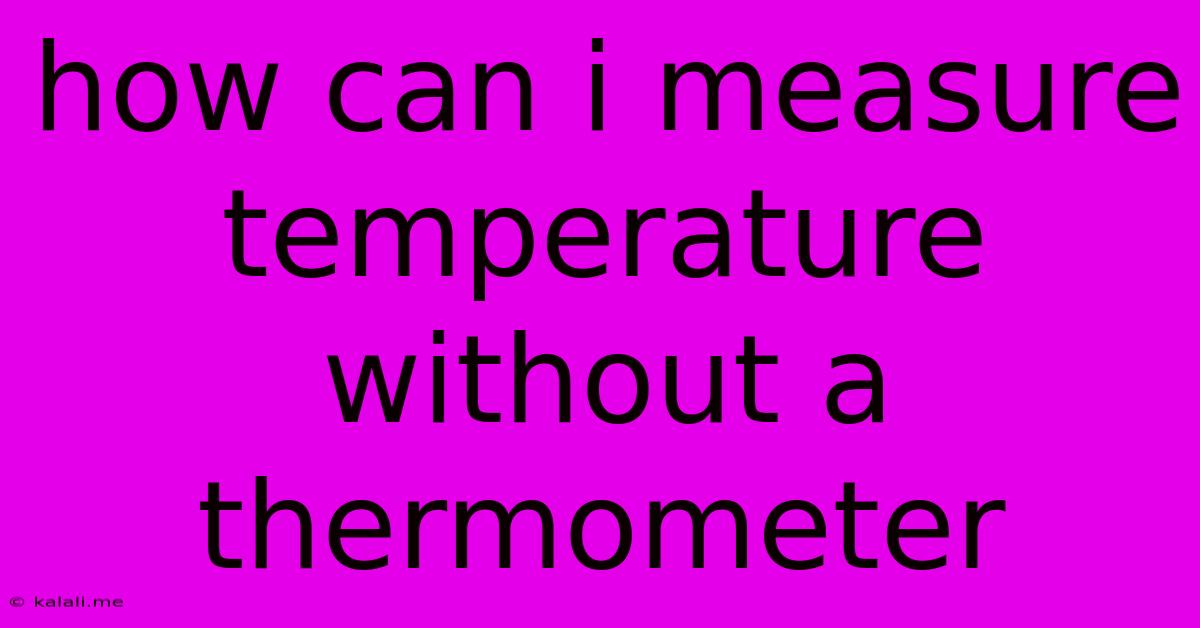How Can I Measure Temperature Without A Thermometer
Kalali
May 24, 2025 · 3 min read

Table of Contents
How Can I Measure Temperature Without a Thermometer?
Meta Description: Learn how to estimate temperature without a thermometer using readily available methods and simple observations, from feeling the air to observing nature's cues. Perfect for emergencies or when you simply want to understand your surroundings better.
Accurately measuring temperature usually requires a thermometer, but there are several methods for estimating temperature when you don't have one readily available. These methods aren't as precise as using a proper instrument, but they can provide a reasonable approximation in various situations. Remember, these are estimations, and accuracy depends heavily on your experience and environmental factors.
Using Your Senses: A Basic Estimation
The simplest method involves using your own senses, though this is the least accurate.
- Feeling the Air: This is the most common method. Gently place your hand in the air and gauge the temperature. This only gives a very rough estimate, differentiating between hot, warm, cool, and cold. It's subjective and will vary depending on individual sensitivity to temperature.
- Observing Your Breath: On a cold day, your breath will be visible as it condenses in the air. The further your breath travels before becoming invisible, the colder it is. Conversely, in hotter conditions, your breath will disappear quickly. Again, this is a very subjective method.
Observing Nature's Cues: More Accurate Estimates
Nature provides various clues that can help you estimate temperature more accurately than simply using your senses alone. These methods benefit from experience and observation.
- Animal Behavior: Animals react noticeably to temperature changes. Observe animal behaviour; birds fluffing their feathers in cold weather, dogs panting excessively in heat, or insects being more active in warmer temperatures can all provide clues.
- Plant Life: Certain plants thrive in specific temperature ranges. The presence or absence of specific plants can indicate a general temperature zone. For example, cacti typically indicate a hot and dry climate.
- Water's Behavior: Observe the water. If a body of water feels warm, the air temperature is likely warmer than if it feels cold. This is particularly helpful near large bodies of water where the temperature might differ from inland areas.
- Evaporation Rate: Water evaporates faster in warmer temperatures. The speed of water evaporating from a puddle or wet surface can be a loose indicator. A quickly evaporating puddle suggests warmer temperatures.
Advanced (and Still Imperfect) Methods
These methods require some knowledge of physics and might need some additional readily-available materials.
- Boiling Water: While not giving you an exact temperature, knowing that water boils at 100°C (212°F) at sea level provides a reference point. If water boils rapidly, you're likely above this temperature. Keep in mind that altitude affects boiling point.
- Rate of Ice Melting: The rate at which ice melts can be a rough indicator. Rapid melting indicates warmer temperatures, slower melting suggests cooler temperatures. This is affected by factors such as wind and humidity, making it less precise.
Limitations and Safety Precautions
It is crucial to understand that all of these methods are estimates and can be influenced by various factors. They should not be relied upon for situations requiring precise temperature measurements, such as medical purposes or scientific experiments. Always use a thermometer when accurate measurements are critical.
Furthermore, be cautious when observing nature; avoid getting too close to wild animals. Always prioritize your safety.
This article provides a range of methods to estimate temperature without a thermometer. While not perfectly accurate, these techniques can be valuable in various situations where a thermometer isn't accessible. Remember to always prioritize safety and rely on a thermometer whenever precise measurement is crucial.
Latest Posts
Latest Posts
-
Add Code To Wordpress Website Body
May 24, 2025
-
Lock Request Time Out Period Exceeded
May 24, 2025
-
Dead Batteries In Thermostat No Eir Conditioning On
May 24, 2025
-
What Is The Book Of The Law In The Bible
May 24, 2025
-
A Is To B As C Is To D
May 24, 2025
Related Post
Thank you for visiting our website which covers about How Can I Measure Temperature Without A Thermometer . We hope the information provided has been useful to you. Feel free to contact us if you have any questions or need further assistance. See you next time and don't miss to bookmark.